Advanced Results
- For the first time, we synthesized the orthorhombic PbFeBO4 single crystals. According to our magnetic measurement data, below the Neel temperature TN = 114 K, PbFeBO4 is a 3D collinear antiferromagnet with the AFM vector directed along the rhombic с axis. We observed anomalies of the dielectric properties of PbFeBO4 near the Neel temperature and attributed them to the interplay of the magnetic and electric subsystems.
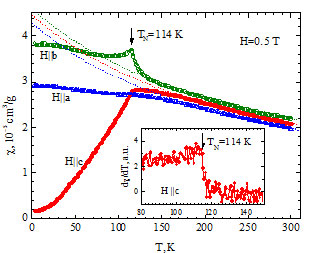

Temperature dependences of magnetic
susceptibility of the PbFeBO4 crystal.Anomalies of the dielectric properties
of the PbFeBO4 crystal. -
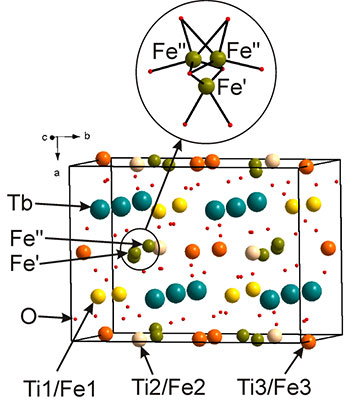
We synthesized polycrystalline RFeTi2O7 compounds with R = Sm, Gd, Dy, Lu, Tu, and Tb and studied them by X-ray diffraction, Mossbauer, calorimetric, and ac and dc magnetic techniques.
We established the spin-glass-like magnetic state of RFeTi2O7 at low temperatures and demonstrated that it results from the competition between the exchange interactions of iron ions in different crystallographic positions.Schematic of the crystal structure of the TbFeTi2O7 compound. Illustration of nonequivalent iron ion positions.
-
We investigated the effect of magnetic field on permittivity of the layered Cu3B2O6 single crystal in the direction perpendicular to the layers, i.e., the bc planes, and noticed the magnetodielectric effect below the Neel temperature (~ 10 K) for only one orientation of magnetic field H, specifically, for H || b. This correlates with the anisotropic behavior of magnetic characteristics of the crystal.
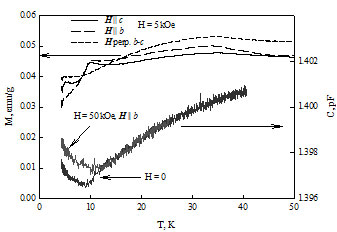
Temperature dependences of the magnetic moment (M axis is the left scale) in the field H = 5 kOe at different orientations of magnetic field H and Cu3B2O6 crystallographic axes and temperature dependences of permittivity in capacitance units (C axis is the right scale) in zero field and in the field H = 50 kOe, H || b.
-
We grew orthorhombic Pb2Fe2Ge2O9 single crystals by a flux technique and studied them by X-ray, magnetic, neutron, Mossbauer, and resonance techniques. Below the Neel temperature ТN = 46 K, the crystals appeared to be antiferromagnets with weak ferromagnetism. The spin-flop fields were experimentally established; the exchange field was estimated. The weak ferromagnetism is shown to result from non-collinearity of single-ion anisotropy axes for the magnetic moments belonging to different magnetic sublattices.
Pb3Mn7O15 single crystals with mixed-valence manganese (Mn3+ and Mn4+) were synthesized. The magnetic, transport, calorimetric, and neutron studies showed that below 250 K the crystals undergo phase transitions: at T ~ 160 K, the short-range antiferromagnetic order forms; at 70 K, the long-range one with a weak spontaneous magnetic moment is established; at 20 K, the spin-reorientation transition occurs. -
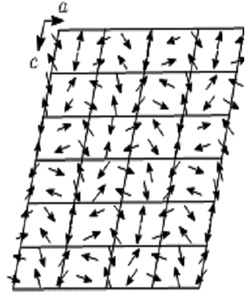
NaFeGe2O6 and LiFeGe2O6 compounds were fabricated by the solid-state synthesis and studied by X-ray, neutron, Mossbauer, calorimetric, and magnetic techniques. The analysis of magnetic peaks in the neutron diffraction pattern shows that at 1.6 K NaFeGe2O6 has an incommensurable magnetic structure in the form of an AFM spiral with the helical modulation in the а-с plane of the crystal lattice (Fig. 1) and the magnetic structure wave vector k = (0.3357(4), 0, 0.0814(3)). Along with the order-disorder magnetic phase transition at ТN = 13 K, NaFeGe2O6 undergoes an additional, apparently orientational, magnetic phase transition at Тс = 11.5 K.
Fig. 1. NaFeGe2O6 spiral magnetic structure
- Study of inelastic neutron scattering on the Cu3B2O6 single crystal showed that below 14 K the energy gap forms in a system of spin excitations; i.e., the singlet spin state is established.
- The magnetic resonance, magnetic and magnetostriction data allowed us to build and analyze the magnetic phase diagrams of the tetragonal CuB2O4 crystal in a magnetic field oriented along its tetragonal axis (Fig. 2) and in the basal plane. The phase diagrams contain the field-induced commensurable weak FM state and a number of modulated magnetic states. The transition from the incommensurate to induced commensurate state at Т < 9.5 K in a magnetic field along the tetragonal axis is shown to be caused by saturation of the weakly ordered subsystem along this direction.
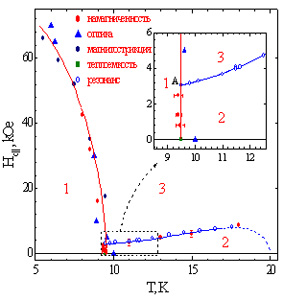
It is suggested that the incommensurable spiral magnetic structure is formed by the expense of eliminating the inter-subsystem exchange frustration in the two-subsystem antiferromagnet. The field dependence of magnetization of CuB2O4 in a magnetic field along the tetragonal crystal axis shows that this mechanism is responsible for the formation of the spiral structure in the magnet at T < 9.5 K.
In the mean-field approximation, we demonstrated possible coexistence of two magnetic subsystems with different wave eigenvectors and the transition of the spin subsystem from the incommensurable to commensurable phase via the phase with different wave vectors of its separate subsystems. Without interaction between the subsystems, each of them is ordered with its own wave vector. At the significant interaction, the system is ordered with the common wave vector. In CuB2O4, this effect is responsible for the occurrence of the intermediate semi-incommensurable state at Т = 1.8 K in the fields 1.3 T < H < 1.8 T at magnetization in the basal plane with only one subsystem staying incommensurable.
Fig. 2. Magnetic phase diagram of CuB2O4 (H||c). (1) Incommensurable, (2) long-range modulated, and (3) weak FM states.
-
We continue studying the magnetic, magnetic resonance, and calorimetric properties of crystals in the huntite family with the general formula RFe3(BO3)4 (R is the rare-earth ion), the magnetic anisotropy of which is determined by contributions of magnetic subsystems of iron and rare-earth ions.
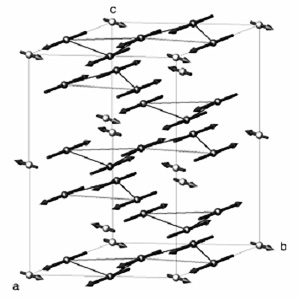
The magnetic resonance study of YFe3(BO3)4 allowed us to establish the magnetic structure of the iron subsystem, separate contributions of the Fe3+ and Gd3+ subsystems to the magnetic anisotropy of GdFe3(BO3)4, and explain the spontaneous orientational transition of the crystal by the competition of the Fe3+ and Gd3+ subsystems. The neutron and magnetic studies of the RFe3(BO3)4 (R = Nd, Tb, Dy, Y, Ho, Pr, and Er) reveal the strong effect of a rare-earth ion on the magnetic structure. We confirmed that the iron subsystem in YFe3(BO3)4 is an easy-plane antiferromagnet with TN = 38 K; such a magnetic structure is found for R = Er. In the neodymium ferroborate below TN = 30.5 K, the easy-plane AFM structure also forms (Fig. 3); however, below 20 K, it is superimposed with the weak long-period incommensurability with the wave vector k = [0, 0, 3x = 3/2 +ε].
Fig. 3. Easy-plane AFM structure.
-
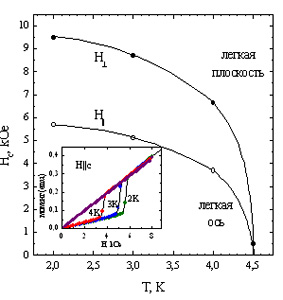
We established the easy-axis AFM structure in terbium, dysprosium, and praseodymium ferroborates. TbFe3(BO3)4 and DyFe3(BO3)4 undergo the metamagnetic transition in a magnetic field along the trigonal axis: the magnetic moments of the rare-earth subsystem are oriented along the field and in the iron subsystem the spin flop occurs. In holmium ferroborate, as in GdFe3(BO3)4, the competition of the magnetically anisotropic contributions of the Fe3+ and Ho3+ subsystems leads to the spin-reorientation transition at Т = 4.7 K (see the magnetic phase diagram in Fig. 4).
Fig. 4. Magnetic phase diagram of HoFe3(BO3)4.
-
The ESR study of the Jahn-Teller effect in the ZnGa2O4 spinel single crystal at 110-560 K shows that copper ions occupy the octahedral 16d positions in the ZnGa2O4 crystal with the cubic symmetry O7h (Fd-3m). At T = 560 K, octahedra undergo tetragonal distortion, mainly tensile, and rotation along the fourth-order axes by θ ≈ 2.6°. The established spin Hamiltonian parameters are determined for extended (g = 2.355, g = 2.077, A = 116 Oe, and A = 12 Oe) and compressed (g = 2.018, g = 2.246, A = 75 Oe, and A = 44 Oe) octahedra. Above 560 K, the static Jahn?Teller effect transforms to dynamic one; the magnetic resonance spectrum becomes isotropic with g = 2.116.
-
We continue complex investigations of the structural, magnetic, magnetic resonance, and transport properties of sulfide compounds of transition metals promising for spintronics. We found that in the system of homogeneous FeXMn1-XS solid solutions with the cubic NaCl structure, substitution of iron for manganese occurs in the octahedral positions and compresses the fcc lattice. Specifying the solid solution composition, we can change room-temperature resistivity by six orders of magnitude (from 105 to 10-1 Ω·сm).
We disclosed the change in the conductivity type from hole (at Х ? 0.3) to metal (at Х = 0.4) in the CoХMn1-ХS system.
-
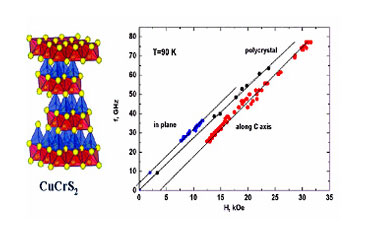
We develop spintronic heterostructures, in particular, layered CuCrS2-based intercalated compounds. Magnetic resonance (Fig. 5) and structural studies show that CuCrS2 single crystals grown by gas transport are heterostructures from alternating layers of the single-crystal CuCrS2 semiconductor and the FM CuCr2S4 spinel with a thickness of no more than 1 µm. We observed the phase transition of CuCrS2 to the spiral AFM structure with the Neel temperature of 37--40 K with the incommensurable propagation vector. The transition is accompanied by the structural transformation R3m > C8m. CuCr1-xVxS2 polycrystals with the colossal magnetoresistance are synthesized.
Fig. 5. Field-frequency dependences of the spinel phase resonance in CuCrS2.
-
Using the Mossbauer effect, we demonstrated that embedding of Fe and Mn in oxide glasses leads to the formation of manganese ferrite particles. We followed the evolution of their magnetic properties vs synthesis conditions.
